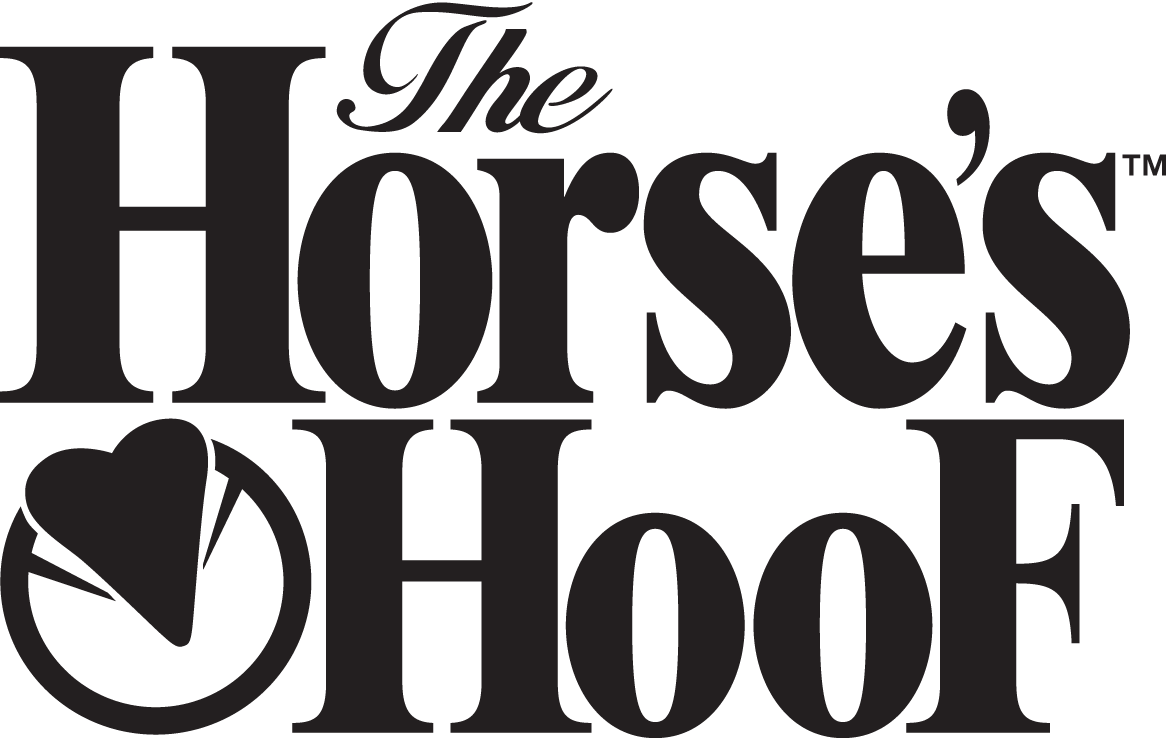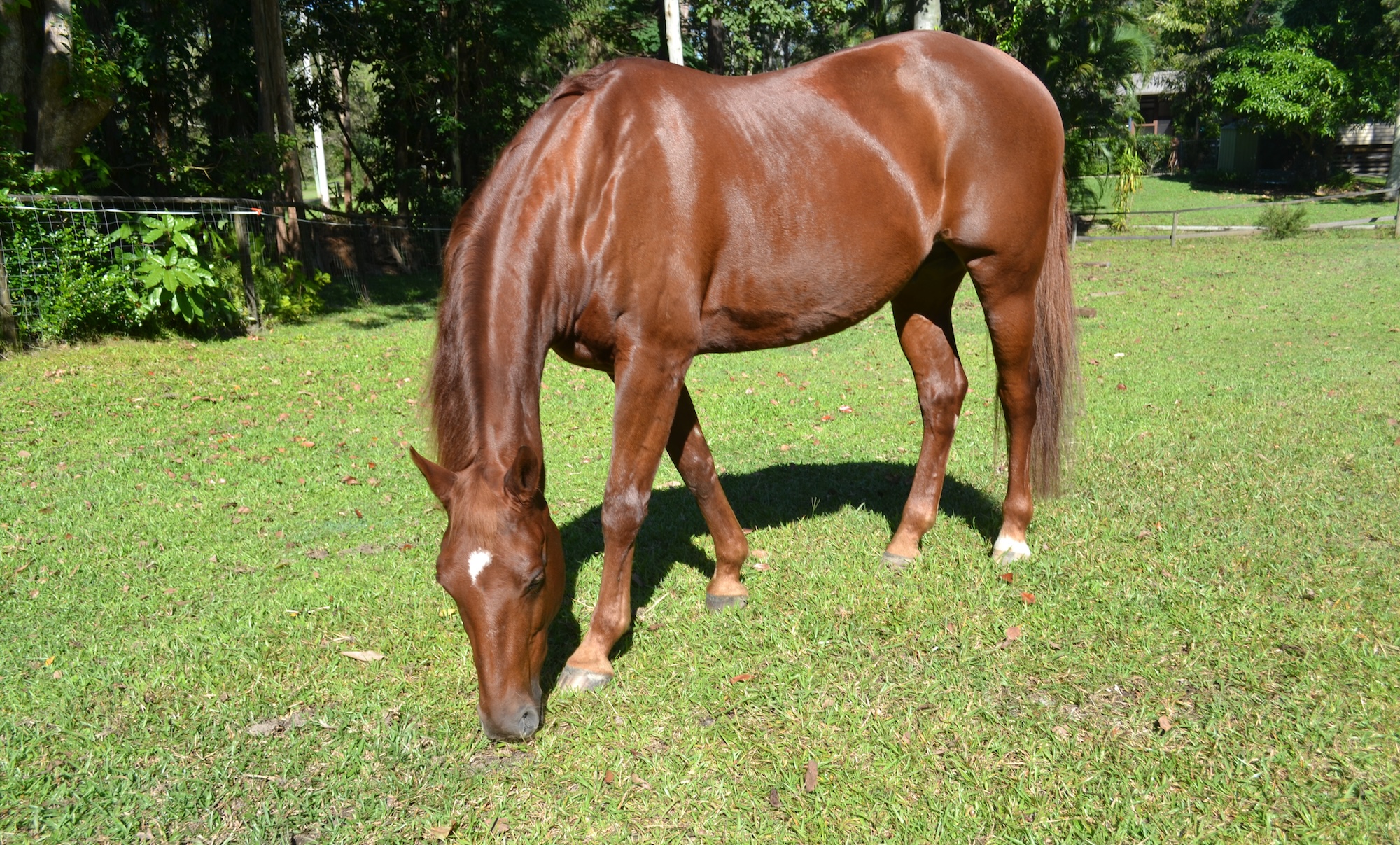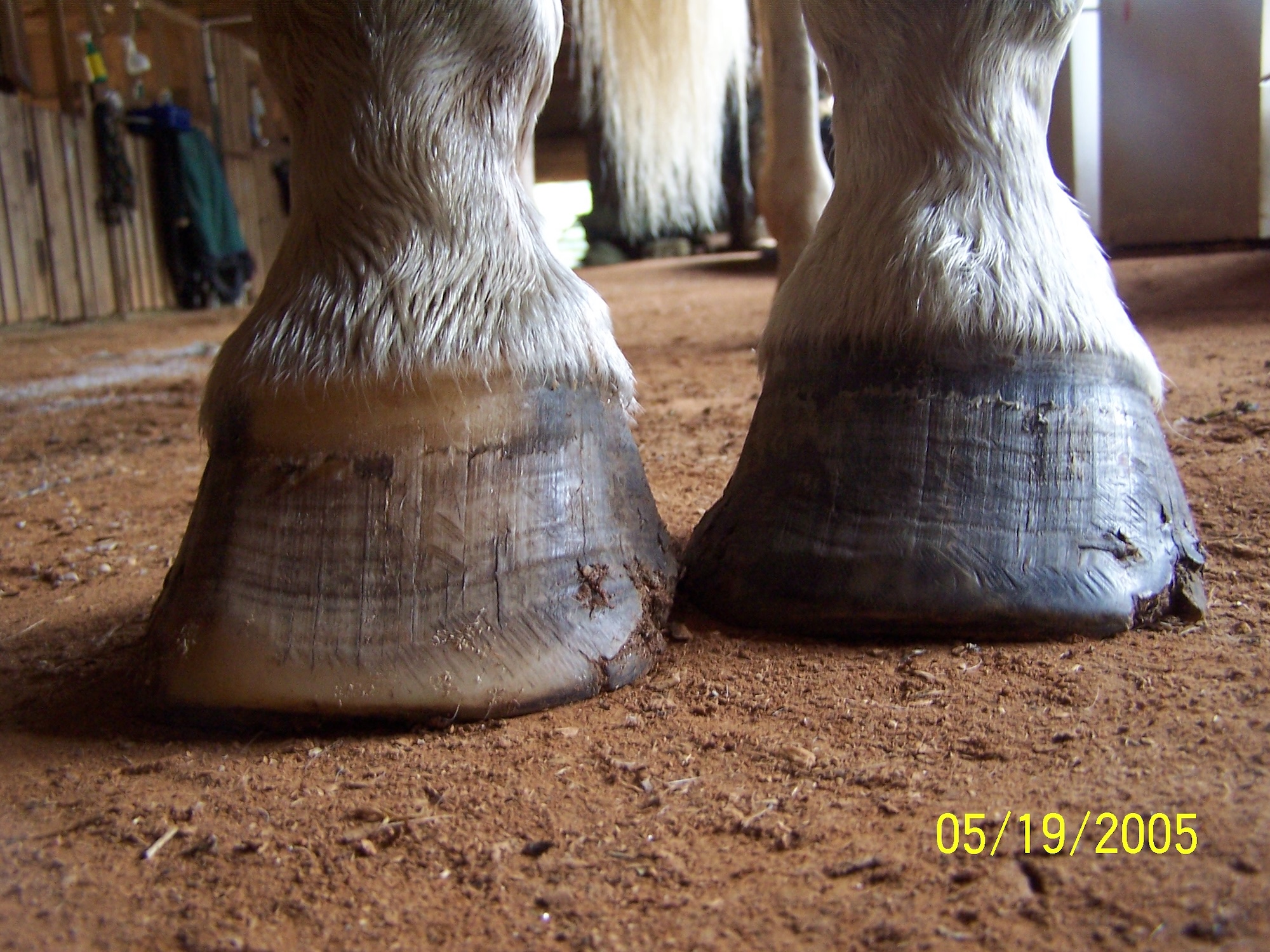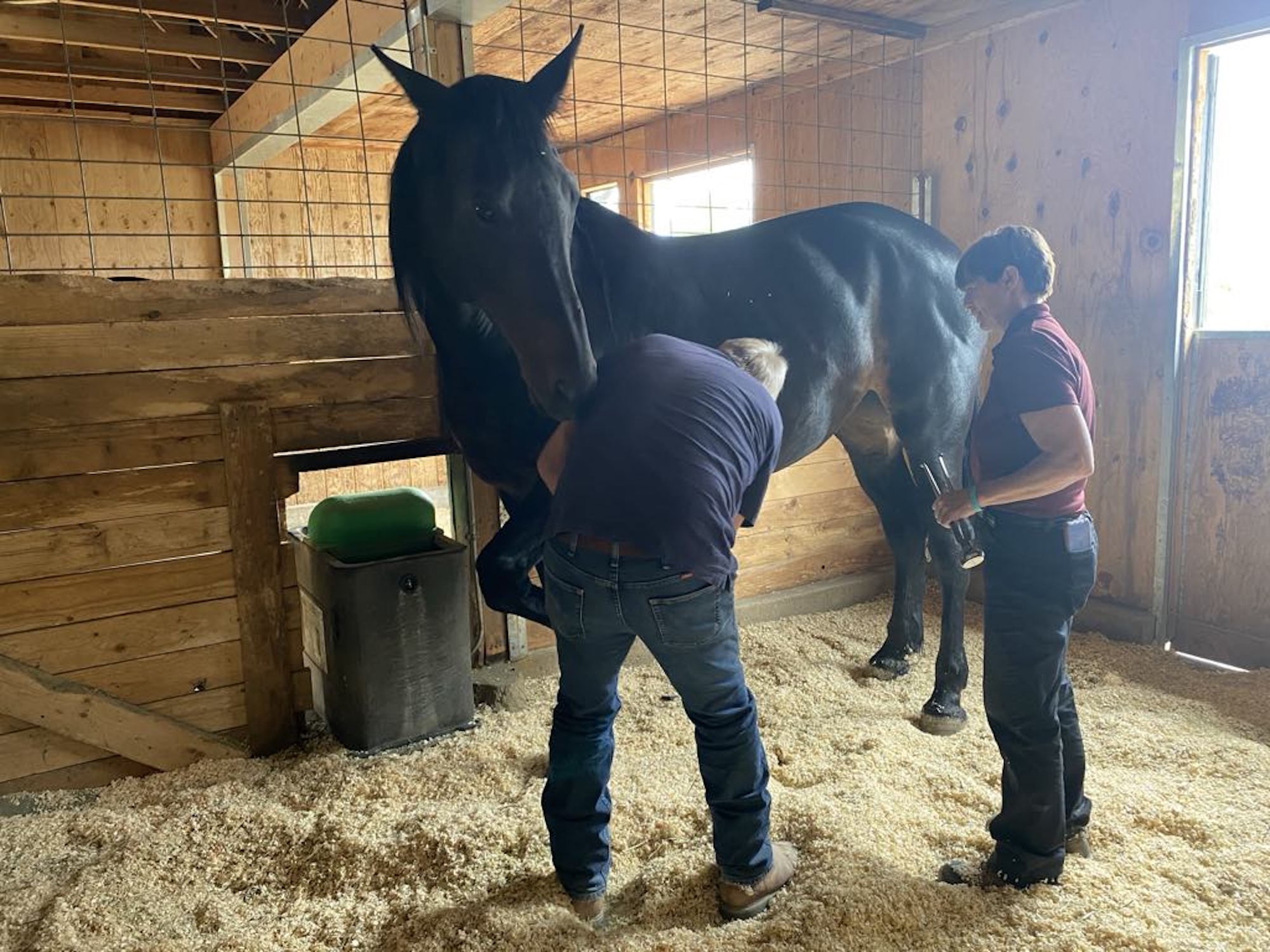If you want your horse to look his best, many people believe that a rug/blanket is essential to stop the sun from bleaching a horse’s coat. A dull and faded coat isn’t a good look for any horse, especially in the show ring or on a competitive performance horse. Other suggestions are to keep the horse indoors during the day, paint or dye the horse with products, or use a high fat ingredient in the diet to give the horse a shiny sheen, but none of these suggestions deal with the actual cause.
A sun-bleached or dull coat is a classic sign of mineral deficiency and/or mineral imbalances and the way to correct this is to put the horse on a more than adequate nutrient and mineral balanced diet.
All photos courtesy Carol Layton

Photos showing dramatic coat changes before and after dietary mineral balancing.
When a horse’s intake is corrected with the right feeds and mineral supplement to complement the forage, it won’t be just the coat that will stop bleaching, but it will also improve hoof quality, fertility, foal health and produce a robust immune system and greater tolerance for the work we ask of our performance horses.
All horses have a requirement for carbohydrates, protein, a small amount of fat, vitamins and minerals and water to stay healthy. Equine nutritionists use the “Nutrient Requirements for Horses,” published in 2007 by the National Research Council to calculate needs for horses. Lactating mares have the highest needs. Growing horses require less total feed, but a higher concentration of minerals compared to mature horses. The greater the body weight or workload, the greater the requirements for protein and minerals. This is why the same diet (pasture and supplementary feed) can appear to support one horse but not another, if one is heavier or is on a higher workload, despite both horses having a good body condition score.
The same can apply to a horse that has his workload increased. The diet may appear to support the horse quite well at the lower workload, but signs of mineral deficiency may be expressed at the higher workload.
Horses most affected by sun bleaching are the darker colors like blacks and bays, but it also affects chestnuts, buckskins, and, to a lesser extent, greys. Some breeds are more affected than others; Friesans, for example, don’t bleach as much. They may be less prone to it because they genetically produce higher concentrations of very dark, protective melanin. Even if they are producing less than normal, it’s still more than most other horses.
It must be said that horses are individuals, so two bay horses of the same weight and breed on the same diet and workload may have one exhibiting a more bleached coat. Both will still have the same mineral deficiencies and/or mineral imbalances.
Copper and Zinc
A copper-dependent enzyme called tyrosinase is responsible for the production of melanin, brownish black pigments synthesized from the amino acid tyrosine.
This occurs in plants and animals, including micro organisms, and us. The lack of tyrosinase activity is responsible for albinism and is related to grey hair in us. Sufficient copper is needed to produce the pigment in buckskins and chestnuts, and both copper and zinc are needed for black/brown/grey coats.
The purpose of the pigments is to act as a shield against light. The fading is caused by ultraviolet light oxidizing the pigments. If there are less than optimal levels in the diet, the hair will be more prone to bleaching, but will look normal until enough pigment has been damaged to cause the color change.

Chestnut coat color is also greatly affected by mineral balance.
That’s why a newly grown winter coat will appear darker, but then lighten over time if the horse is copper and zinc deficient. If your horse is on a more than adequate nutrient and mineral balanced diet, there is no need for rugging or worse, kept indoors.
Copper deficiency in other species influences coat quality and produces “rusting” of dark coats; this is especially noticeable in the manes of bays and black horses. This effect in horses has not been formally proven, but horses showing red tips on dark manes of dark coats respond well to copper and zinc supplementation.

Coat changes can happen quickly with improved nutrition: Left photo is Ares in February 2013; right is Ares in June 2013 (which is wintertime in Australia).
It’s not enough to simply ensure sufficient levels of copper and zinc in the diet; the balance between the two must also be considered, as too much zinc in the diet has been shown to interfere with copper uptake. This is known as a secondary copper deficiency. Too much copper in the diet is believed to interfere with zinc uptake. Some people add copper sulfate to a feed; this is not a good practice without taking into account the copper and zinc intake for the whole diet (pasture plus any additional feeds). The ideal ratio for copper to zinc is 1:3.
A secondary copper deficiency can be caused by other factors. High molybdenum and sulfates from a contaminated water source or grazing on affected pasture is known to interfere with copper intake. Some horse owners add inorganic yellow sulfur to their horses’ feeds. There is a very small requirement for sulfur in a horse’s diet that is easily satisfied by grass or hay, the yellow sulfur obtained from stockfeed suppliers should never be fed to a horse—it can be toxic.
A copper deficiency may be obvious with coat color changes, but can be more subtle in other parts of the body. Copper is part of many enzymes responsible for chemical reactions throughout the body. A deficiency can lead to abnormalities in bone, cartilage, tendons and ligaments and has been linked to uterine artery rupture in mares, a fatal complication of labor. Zinc deficiency is linked to developmental bone disease in foals.
Studies in other animals have shown that a high iron intake can interfere with zinc levels, causing a secondary zinc deficiency. Since pasture and hay generally have excessive levels of iron, avoid supplements that add more iron to your horse’s diet, unless an iron deficiency is confirmed by your vet. It’s worth noting that anaemia due to iron deficiency is extremely rare in mature horses; more likely caused by a copper deficiency, as the production of the oxygen carrying haemoglobin for red blood cells requires a number of crucial copper dependent enzymes. A vitamin E deficiency can cause red blood cell fragility, and garlic supplementation can cause Heinz cell anaemia.
A standard blood test can only indicate the blood status for iron. The only laboratory in the world calibrated for equines that can test for the body status of iron is in America. Kansas State University will do an iron panel consisting of serum iron, ferritin and TIBC (protein; total iron binding capacity). Transferrin saturation (serum iron/TIBC) is often high in iron overload, but can also be high with any type of inflammation.
A zinc deficiency can cause a raft of issues, from skin flaking and poor coat quality to poor fertility, poor hoof quality and ridging, mouth ulcers, mild anaemia (oxidative damage), suboptimal immunity and predisposition to skin infections.
Other Nutrients
Of course, it’s not just copper and zinc, but protein, vitamins and other minerals also need to be part of the balanced diet. Fortunately, the good news is that if your horse is on a high-intake grass diet, most of the vitamins will be supplied, and won’t need supplementing. An exception is vitamin E, if your horse is in work. Fresh green grass is the best feed for horses, though not for the sugar sensitive or insulin resistant/laminitic prone horse if the grass is too high in sugars and starch.
The motto to remember is that “more is not better.” If there is more than adequate protein in your horse’s pasture, supplementing more is not helping your horse at all, as the excess will be excreted.

Improvement in the coat color of a bay horse, through supplementation.
Keratin is an extremely strong protein and is the major component in skin, mane and tail, hooves, and teeth, as is the case for us with our skin, hair and nails. Keratin is made up of a chain of amino acids with unique properties depending on the sequence; it can be inflexible and hard, like hooves, or soft, as is the case with skin, depending on the levels of the various amino acids.
Many of the amino acids that are needed for keratin are never deficient; horses can manufacture them from other amino acids. One that has to come from the diet is methionine, as it cannot be manufactured by the horse. Methionine has a sulfur bond which has confused some people into thinking that sulfur should be supplemented in the diet. Feeding sulfur doesn’t create more methionine, but fortunately, methionine is in grass and hay and is unlikely to be deficient, unless the horse is on a high grain diet with little forage.
The last consideration should be given to fat in the diet. Many people supplement vegetable oils, like canola or rice bran oil, to add a shine to their horse’s coat. Without taking into account the whole diet, rectifying any deficiencies and balancing the minerals, this simply results in a shiny, mineral deficient horse. Since horses evolved on a low fat intake (less than 6%), is this in the best interests of the horse?
Fat is never deficient in the diet if grass is the predominant forage. There is no necessity to supplement more fat, unless the horse is on little pasture, and hay plus supplementary feed are fed to replace it. Grass is a rich source of the anti-inflammatory omega-3 and pro inflammatory omega6 fatty acids in a ratio of roughly 4:1. Both are necessary for the immune system. Unfortunately, all vegetable oils, with the exception of linseed (flaxseed) and chia seeds, contain very little to no omega-3 and an abundance of omega-6 fatty acids. If your horse is mainly fed hay and supplementary feed, linseed (flax) oil or freshly ground linseeds (flax) should be supplemented, because the curing of hay destroys the fragile omega-3 fatty acids.

Hooves benefit, too! Above shows changes since mineral balancing was introduced 6 months earlier to this older horse. Below is a horse where the horse owner isn’t too great on hoof care—but at least tried the minerals. And it worked.

The next time you visit your stockfeed supplier or saddlery, have a look at all the coat, mineral and hoof supplements—the two minerals they will all have in common is copper and zinc. Ask an independent nutritionist to help you have your pasture and/or hay tested, and a mineral supplement formulated to correct any nutritional deficiencies and balance the minerals. Let your horse be the color his genes designed him to be.
About the author: Carol Layton B.Sc M.Ed (Balanced Equine) is an Independent Equine Nutritionist. Carol tutors students in Dr Eleanor Kellon’s VMD nutrition courses. She is passionate about sharing her knowledge on how to feed horses optimally, and to explain the many myths, fads and marketing, so that feeding is simple, holistic and cost-effective for high performance horses or those predisposed to laminitis. A keen endurance rider, her horse Omani Mr Sqiggle was a 2009 Australian Points and Distance horse. Visit her website Balanced Equine https://balancedequine.com.au
by Carol Layton B.Sc M.Ed, published in The Horse’s Hoof Magazine, Issue 55, Summer 2014
See the full content listing of all issues of The Horse’s Hoof Magazine! We also provide instructions on how to read the issues for free on Hoof Help Online.
For a detailed listing of all articles on The Horse’s Hoof website, please visit our Article Directory.




